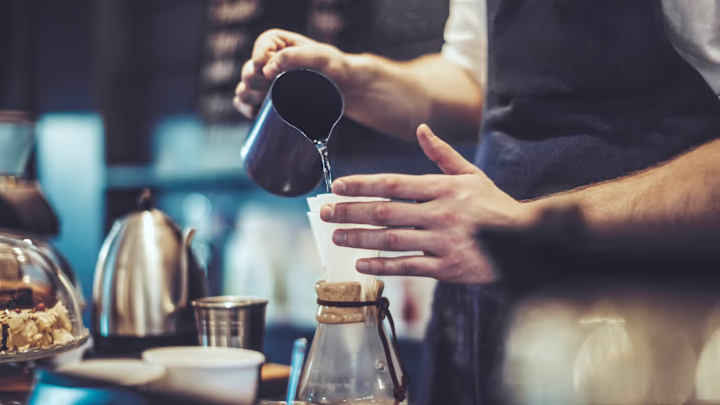If you're tired of drinking the same homemade coffee every morning, it might be time to learn a few new tricks that will help you brew cafe-quality java right in your own kitchen. To learn some easy ways to improve your coffee, we spoke to three experts: Brennon Nunn of Sip & Sonder, a coffee house and roastery founded in Inglewood, California; Adam JacksonBey, chair of GoFundBean, a nonprofit organization devoted to uplifting and supporting hourly coffee professionals; and Chi Sum Ngai of Coffee Project NY, a coffee shop, roastery, and coffee education center. Here's what they had to say about brewing to your potential.
1. Take your time with a cup of pour-over coffee.

Since coffee is their career, our experts aren't drinking tons of it on their days off—but they do like to focus on enjoying at least one really great cup, often preferring the slower, more thoughtful pour-over method when they're on their own time. Though it takes a bit more effort, the robust flavor more than makes up for it.
To achieve a quality pour-over cup at home, Sum uses a V60 cone dripper. This model from Hario (from $20) comes in different choices of materials—porcelain, glass, and copper ($56)—and is the industry standard for pour-over. Sum also uses the Kalita Wave ($25) flat dripper when she wants more body in her coffee.
2. Invest in a quality grinder.

Another consensus among our experts was to utilize a burr grinder, which uses burr plates to crush the beans for a more consistent grind size, leading to better flavor extraction. But “any grinder is better than no grinder,” Nunn says.
A hand grinder, like the Hario ceramic coffee mill (from $34), is a great option. Sum likes these because they’re easy to use and cost-friendly, but she also recommends investing in an electric burr grinder if you’re making coffee every day. The compact Bodum Bistro burr coffee grinder ($38) has 12 grind settings and is fairly affordable. If you're pickier about the grind size, the Baratza Encore conical burr coffee grinder ($170) has 40 grind settings. Sum also suggests the Fellow Ode brew grinder ($299), which she uses for pour-over coffee. Whichever grinder you go for, you should clean it regularly—every four to six weeks, according to JacksonBey.
Sum also recommends “resting” coffee beans, which means letting a bag of coffee beans sit for a bit after the roast date. When coffee is rested, it is degassed and your coffee will be “clearer and tastier.” A good start would be around seven to 14 days, depending on the roast level. And if your coffee lacks flavor, Sum says you should “grind it a little finer and increase the contact time [between your] water and coffee.”
3. Use a scale for precise measurements.

JacksonBey says that people generally like a ratio of 1 gram of coffee to 16 to 21 grams of water. And to get those measurements just right, you'll want to grab a scale to be as accurate as possible. This type of precision is key for consistency once you find the perfect ratio for your taste.
The OXO Good Grips precision scale ($55) is a sleek-looking scale that measures from 0.5 grams and up, in 0.1 gram intervals, for maximum accuracy. The flat surface also makes it easy to clean.
4. Get your water temperature right.

“Different temperatures are required for different brews,” Nunn says, so our experts recommend using a gooseneck kettle to control water flow and temperature, and to opt for a temperature-controlled kettle if you're particular about how hot you want your coffee. JacksonBey aims for 128°F and stresses to only use filtered water.
The Fellow Stagg electric pour-over kettle (from $159) is a beautiful, modern-looking gooseneck kettle that can be controlled to the degree from 135°F to 212°F for optimal coffee brewing and tea steeping. It's also Bluetooth-enabled and iOS compatible.
5. Don't be afraid to experiment.

Since many people are home more often these days, now is a great time to experiment and figure out your personal coffee preferences. By playing with ratios, temperatures, times, and other factors, you can figure out what type of coffee you like best.
“Coffee is experimentation, and coffee is trying things that you wouldn't expect,” JacksonBey says. Nunn agrees, and whether it's your local coffee shop or at-home experimentation, he recommends going out (safely!) and trying out different coffees to see what is out there and what you might find you enjoy.
Sum, for example, says she has been drinking more espressos recently. Although she uses an espresso machine at work, she also likes the Flair espresso maker ($125) because it's compact and doesn't require electricity. This makes it a convenient tool for in the home and, as Sum suggests, on a camping trip.
Nunn likes the Bialetti Moka ($32) pots to produce a stronger brew closer to espresso. “They're great for at-home like espressos and very straightforward.”
If you'd like to help out hourly coffee professionals, please check out GoFundBean. You can support them by heading to their Patreon, signing up for their newsletter, or donating.
This article was originally published in 2021. It has been updated for 2022.
